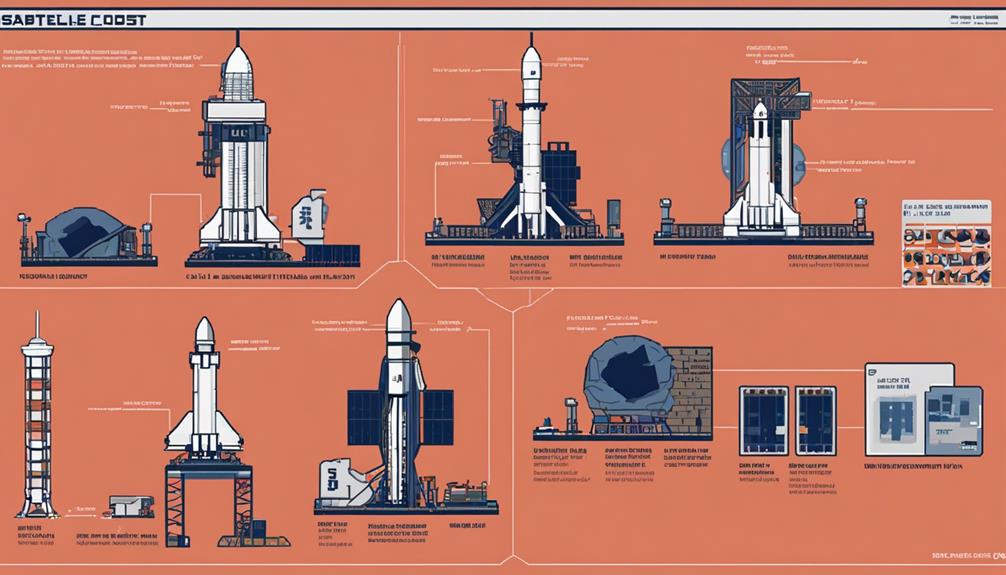The intricate web of financial intricacies surrounding SpaceX's satellite launches unravels a complex landscape of cost structures, pricing models, and economic impacts. Understanding the factors influencing launch costs and revenue streams in the satellite launch industry is crucial in deciphering the competitive dynamics at play. As we delve into the depths of this topic, the interplay of innovation, sustainability practices, and future trends in the space economy will undoubtedly shed light on the trajectory of this burgeoning sector.
Key Takeaways
- SpaceX's competitive pricing and cost efficiency drive increased demand and economic efficiency in satellite launches.
- Diverse pricing strategies in the industry cater to various payload specifications, shaping competitive dynamics.
- Revenue growth is anticipated to be primarily fueled by Starlink sales, surpassing rocket launch revenue.
- SpaceX's market impact includes revolutionizing launch capacity with Starship, influencing industry evolution and competitiveness.
Cost Structures of SpaceX Satellite Launches

The cost structures of SpaceX satellite launches have revolutionized the economics of space transportation by offering a highly competitive pricing model that averages around $62 million per launch. This drastic reduction in launch costs, facilitated by the Falcon 9 rocket, has reshaped the landscape of satellite deployment. The competitive launch prices provided by SpaceX stand in stark contrast to the significantly higher costs associated with traditional methods such as NASA's space shuttles.
With SpaceX's affordable launch services, a broader range of customers, including commercial entities and government agencies, can now access space for satellite deployment. The cost-effectiveness of SpaceX satellite launches has not only driven rapid growth in satellite utilization but has also played a pivotal role in democratizing access to space for various stakeholders. By leveraging the Falcon 9 rocket and optimizing operational efficiencies, SpaceX has set a new standard for cost-efficient satellite launches in the industry.
The $62 million average launch cost for SpaceX satellites signifies a significant milestone in making space more accessible and economically viable for a multitude of applications, ranging from telecommunications to Earth observation. This competitive pricing model has not only propelled SpaceX to the forefront of the commercial space sector but has also catalyzed advancements in satellite technology and utilization.
Pricing Models for Satellite Launches
Amidst the burgeoning commercial space industry, satellite launch providers employ diverse pricing models tailored to payload specifications and mission requirements. Rocket Lab, for instance, offers satellite launches at around $5 million per flight, appealing to customers with smaller payloads or specific destination orbits. In contrast, SpaceX's pricing for satellite deployment is typically around $62 million per launch, reflecting its larger capacity rockets and ability to cater to a wider range of mission demands.
Pricing models for satellite launches are intricately linked to factors such as payload size, destination orbit, and specific customer requirements. Providers often offer customized pricing options to address the varied needs of satellite operators, ensuring that each mission is tailored to achieve optimal results. The competitive landscape also plays a significant role in shaping pricing strategies for satellite launches, with companies adjusting their pricing to attract customers in a crowded market.
Moreover, considerations like launch vehicle capacity and reusability further influence the pricing models adopted by satellite launch providers. By strategically positioning their offerings and adapting to market dynamics, companies seek to maintain a competitive edge while delivering cost-effective solutions to a broad spectrum of satellite operators.
Economic Impact of SpaceX Launches

SpaceX's competitive pricing strategy and enhanced cost efficiency have reshaped the landscape of satellite launches, profoundly impacting the economics of the space industry. The lower launch costs offered by SpaceX have played a pivotal role in reducing the overall expenses associated with satellite launches. This reduction in costs has had a significant economic impact, enabling more companies and organizations to access space at a more affordable rate compared to traditional methods.
| Economic Impact of SpaceX Launches | |
|---|---|
| Lower Launch Costs | More affordable access to space |
| Competitive Pricing | Wide range of customers attracted |
| Economic Efficiency | Increased demand for services |
The economic efficiency of SpaceX's satellite launches has not only benefited the company but also the industry as a whole by providing more cost-effective solutions. The competitive pricing strategies implemented by SpaceX have led to a surge in demand for their services, further solidifying their position in the satellite launch market. By disrupting the traditional satellite launch industry, SpaceX has set a new standard for economic viability in space exploration, paving the way for a more sustainable and accessible future in satellite launches.
Factors Influencing Launch Costs
The cost of satellite launches is influenced by various factors, with the choice of launch vehicle playing a crucial role in determining expenses. Moreover, the mass of the payload has a direct impact on launch costs, as heavier payloads require more energy for transportation. Additionally, reusability stands out as a key factor in reducing overall launch costs, as it enables significant savings on manufacturing and refurbishment expenditures.
Launch Vehicle Selection
Launch vehicle selection is a critical determinant of the economic efficiency of satellite launches, with factors such as payload capacity, rocket reusability, and launch frequency playing key roles in influencing launch costs. SpaceX's Falcon 9, renowned for its cost-effective performance, has become a preferred choice for satellite deployments due to its reliability and reusability features. The Falcon 9's optimized design allows for efficient utilization of its payload capacity, contributing to lower launch costs per kilogram of payload. By selecting the Falcon 9, SpaceX leverages the benefits of reusable rocket technology, further reducing the overall expenses associated with satellite launches. The choice of launch vehicle, such as the Falcon 9, is pivotal in achieving cost-efficient satellite deployments while maintaining high mission success rates.
Payload Mass Impact
With payload mass serving as a primary determinant, the economic viability of satellite launches hinges significantly on the selection of an appropriate rocket size and fuel requirements.
Factors Influencing Launch Costs:
- Payload Mass Impact: The mass of a payload directly influences the cost of a satellite launch by determining the required rocket size and fuel consumption.
- Rocket Size: Heavier payloads necessitate larger, more powerful rockets, leading to increased launch costs.
- Falcon 9 Capacity: SpaceX's Falcon 9 rocket can carry up to 22,800 kilograms to low Earth orbit, impacting pricing for different payload sizes.
- Rideshare Missions: Smaller payloads can be more cost-effective as they can be accommodated on rideshare missions or shared launches, optimizing cost efficiency in the satellite launch market.
Reusability Benefits
Reusability benefits in SpaceX's satellite launches have revolutionized cost efficiency through significant reductions in launch expenses. By refurbishing Falcon 9 boosters for multiple flights, SpaceX saves approximately $46.5 million per launch, directly impacting launch costs. This approach minimizes the necessity for new rocket production and allows for competitive pricing strategies in the satellite launch market. The ability to offer lower prices due to reusability attracts more customers, consolidating SpaceX's position as a cost-effective launch provider. Overall, the incorporation of reusability features in rocket design has reshaped the economics of satellite launches, emphasizing cost-effectiveness and sustainable practices in the space industry.
Revenue Streams in Satellite Launch Industry
SpaceX's revenue streams in the satellite launch industry are diversified, comprising various sources such as contracts with commercial entities, government agencies, and international organizations. Analyzing market demand trends allows SpaceX to align its offerings with current needs, ensuring a steady income flow. The company's competitive pricing strategies enable it to capture market share while maintaining profitability in the highly competitive satellite launch industry.
Revenue Sources Analysis
Amidst the dynamic landscape of the satellite launch industry, an analysis of revenue sources reveals a pivotal shift towards Starlink sales as the primary driver of revenue growth for SpaceX. This shift is evident from the following observations:
- Starlink Sales: Predicted to surpass revenue from rocket launches.
- Revenue Growth: Expected to be primarily fueled by Starlink.
- Global Expansion: Plans indicate a significant increase in Starlink sales revenue.
- Dominant Revenue Stream: Starlink projected to become the leading revenue source, potentially exceeding all other sources.
These factors underline the strategic importance of Starlink in shaping the revenue trajectory of SpaceX, signaling a transformative phase in the company's financial landscape.
Market Demand Trends
The burgeoning demand for satellite launches in the industry is being notably influenced by the proliferation of small satellite constellations and the diverse applications they serve. Small satellite constellations, used for communication, remote sensing, and other purposes, are driving this increased demand. SpaceX's competitive pricing strategies and reliable launch services have positioned it favorably in this expanding market. The company's revenue streams from satellite launches, including commercial contracts, government launches, and the Starlink program, are crucial for its financial performance and growth. By catering to a wide range of satellite launch needs, SpaceX has solidified its position as a key player in the satellite market, meeting the evolving demands of customers seeking efficient and cost-effective launch solutions.
Competitive Pricing Strategies
The evolution of competitive pricing strategies in the satellite launch industry is reshaping revenue streams and market dynamics, catalyzed by the emergence of commercial launch providers offering diverse pricing options to satisfy varying customer needs.
Competitive Pricing Strategies:
- SpaceX charges around $62 million per launch, altering the traditional cost landscape.
- Rocket Lab offers flights at approximately $5 million, showcasing a wide range of pricing strategies.
- New commercial providers like SpaceX and Rocket Lab introduce competitive pricing options for satellite launches.
- Lower costs democratize space access, benefiting companies with large satellite fleets like Planet.
Competition in the Satellite Launch Market
In the competitive landscape of the satellite launch market, SpaceX contends with other commercial providers like Rocket Lab and Arianespace for market share and customer contracts. Rocket Lab, offering launches at approximately $5 million each, presents a cost-effective alternative to SpaceX's pricing. Arianespace, known for its Ariane 5 and upcoming Ariane 6 rockets, stands as another prominent player in the commercial space launch industry. The competition among these launch providers not only fosters rivalry but also drives innovation, efficiency, and cost-effectiveness in the satellite launch sector. Customers benefit from this competitive environment by having a range of choices based on factors such as pricing, payload specifications, and launch timelines.
| Launch Provider | Key Features |
|---|---|
| SpaceX | Reusable Falcon rockets |
| Rocket Lab | $5 million per launch |
| Arianespace | Ariane 5 and Ariane 6 |
The presence of multiple commercial space launch providers intensifies the competition in the satellite launch market, ultimately pushing companies to enhance their offerings and services to attract customers and secure contracts. This competitive dynamic contributes to the overall growth and advancement of the satellite launch industry.
Innovation in Satellite Launch Technologies

Pioneering advancements in satellite launch technologies have propelled SpaceX to the forefront of innovation in the commercial space industry. SpaceX's innovative approach to satellite launches has reshaped the industry landscape, particularly through the utilization of reusable rockets. Here are key points highlighting the innovation in satellite launch technologies:
- Reusable Rockets: SpaceX has revolutionized satellite launches by introducing reusable rockets. This breakthrough technology allows the company to recover and refurbish rockets for multiple missions, significantly reducing the cost of satellite launches.
- Cost Reduction: The use of reusable rockets by SpaceX has brought about a substantial decrease in the cost of satellite launches. By reusing the most expensive parts of the rocket, SpaceX has made satellite deployment more economically viable.
- Multi-Satellite Deployment: SpaceX's Falcon 9 rocket is capable of carrying multiple satellites on a single launch. This capability enhances operational efficiency and flexibility for satellite deployment missions.
- Efficiency and Reliability: Advancements in satellite launch technologies have not only reduced costs but also improved efficiency and reliability. SpaceX's innovations have led to more streamlined processes and increased success rates in satellite launches.
SpaceX's trailblazing efforts in developing and implementing innovative satellite launch technologies have not only disrupted the traditional market but have also set new standards for efficiency, cost-effectiveness, and reliability in the satellite launch industry.
Sustainability Practices in Space Exploration
As the commercial space industry expands rapidly, the implementation of sustainable practices in space exploration becomes increasingly critical to mitigate congestion and space debris in low Earth orbit. Sustainable practices are essential to manage the environmental impacts of space activities, especially with the rise of satellite internet and communication satellites that rely on operations in low-Earth orbit.
| Key Aspects of Sustainability Practices | Description | Importance |
|---|---|---|
| Debris Mitigation | Implementing strategies to reduce space debris through responsible satellite disposal and collision avoidance. | Critical to safeguard operational satellites and spacecraft from collisions. |
| Orbital Traffic Management | Developing systems to monitor and regulate the increasing volume of satellites in orbit to prevent congestion and potential collisions. | Essential for ensuring safe and efficient satellite operations for communication and Earth observation. |
| Sustainable Propulsion Systems | Utilizing eco-friendly propulsion technologies to reduce the environmental impact of satellite launches and maneuvers. | Vital for minimizing the carbon footprint of space activities and ensuring long-term sustainability. |
These sustainability practices are crucial for maintaining a balance between the economic benefits of the commercial space industry and the need for safe and sustainable operations in space. Global cooperation and the establishment of regulations are essential to promote sustainability in space exploration and satellite launches as the industry continues to evolve.
Future Trends in Space Economy

The growth of the space economy in 2021, valued at $469 billion, sets the stage for analyzing future trends in satellite deployment and launch capacity to meet evolving market demands.
Future Trends in Space Economy:
- Satellites in Orbit: With the projected increase in satellite deployments, especially in high-demand scenarios, the number of satellites in orbit is expected to exceed 65,000 by 2030. This rise in satellite numbers will require enhanced launch capacity and efficiency.
- SpaceX's Role: SpaceX, a key player in the space industry, is poised to significantly impact future trends. The introduction of SpaceX's Starship is expected to revolutionize industry capacity and launch economics, potentially addressing both short-term launch challenges and long-term oversupply risks.
- Market Evolution: Industry leaders like Arianespace, ULA, Blue Origin, Firefly, Northrop Grumman, and Rocket Lab are actively developing new launch capabilities to cater to the evolving market demands. These advancements aim to enhance launch frequency, reduce costs, and improve overall efficiency in satellite deployment.
- McKinsey's Projections: McKinsey's growth scenarios up to 2030, based on varying satellite deployment assumptions, provide valuable insights into the future trends of the space economy. By considering high, base-case, and low demand situations, stakeholders can better prepare for the upcoming changes in the industry landscape.
Frequently Asked Questions
What Is the Main Source of Revenue for Spacex?
SpaceX's primary revenue stream is derived from its satellite services, particularly its Starlink constellation. The deployment of satellites for global connectivity drives significant revenue growth for the company. While SpaceX is renowned for its rocket launches, the economic impact of satellite deployment, especially through Starlink, is projected to surpass traditional launch economics and become the main source of income for the company.
How Much Does It Cost for Spacex to Launch?
The cost breakdown for SpaceX launches varies depending on factors like payload weight, destination, and mission complexity. SpaceX's launch efficiency, driven by reusable rocket technology, has significantly reduced costs compared to traditional methods. Market competition plays a role in pricing, with SpaceX's offerings influencing overall industry costs. These elements contribute to the dynamic pricing structure for SpaceX's launches, ranging from tens of millions to over a hundred million dollars per mission.
Is Starlink Making a Profit?
Starlink has achieved profitability, marking a significant milestone in the satellite internet market. With market competition intensifying, Starlink's ability to turn a profit showcases its strong position. The global coverage provided by Starlink's satellite network has attracted over two million subscribers, highlighting robust consumer demand for reliable internet services. This success not only benefits SpaceX's valuation but also demonstrates the viability of satellite internet as a lucrative business venture.
How Profitable Is Spacex?
SpaceX's profitability is robust, with diverse revenue streams contributing to its success. The company's launch pricing strategies are competitive, enabling them to secure contracts while maintaining healthy margins. Despite market competition, SpaceX's efficient operations and innovative technologies have positioned them as a leader in the space industry. With a track record of financial stability and growth, SpaceX continues to demonstrate its profitability and resilience in the market.

